BAF-5-FOF Fundamentals of Finance: Investment Appraisal and Analysis
VerifiedAdded on 2023/06/13
|18
|4421
|51
Report
AI Summary
This report provides a comprehensive analysis of investment appraisal techniques, focusing on the financial viability of a project proposal for Hoodoo Inc. It identifies sensitive variables such as selling price, initial capital investment, and cost of capital, and calculates the weighted average cost of capital (WACC). The report amends the initial investment appraisal, correcting errors made by a trainee, and recalculates the Net Present Value (NPV), Internal Rate of Return (IRR), and Payback Period. The analysis highlights the advantages and limitations of the financial techniques used, ultimately providing recommendations for the drafted project. The corrected calculations reveal a positive NPV, indicating the project's financial viability. Desklib offers a wealth of similar solved assignments and study resources for students.
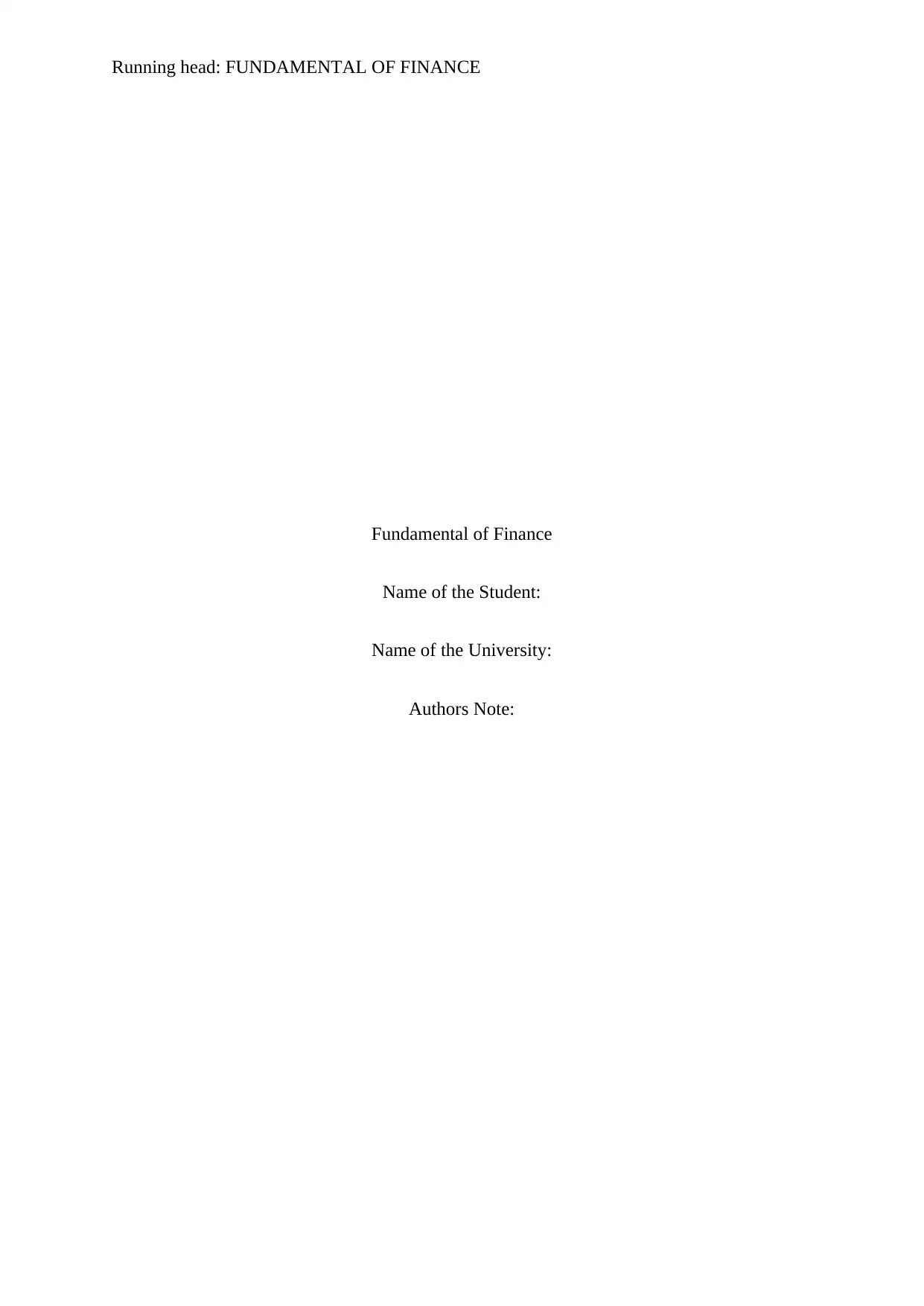
Running head: FUNDAMENTAL OF FINANCE
Fundamental of Finance
Name of the Student:
Name of the University:
Authors Note:
Fundamental of Finance
Name of the Student:
Name of the University:
Authors Note:
Paraphrase This Document
Need a fresh take? Get an instant paraphrase of this document with our AI Paraphraser
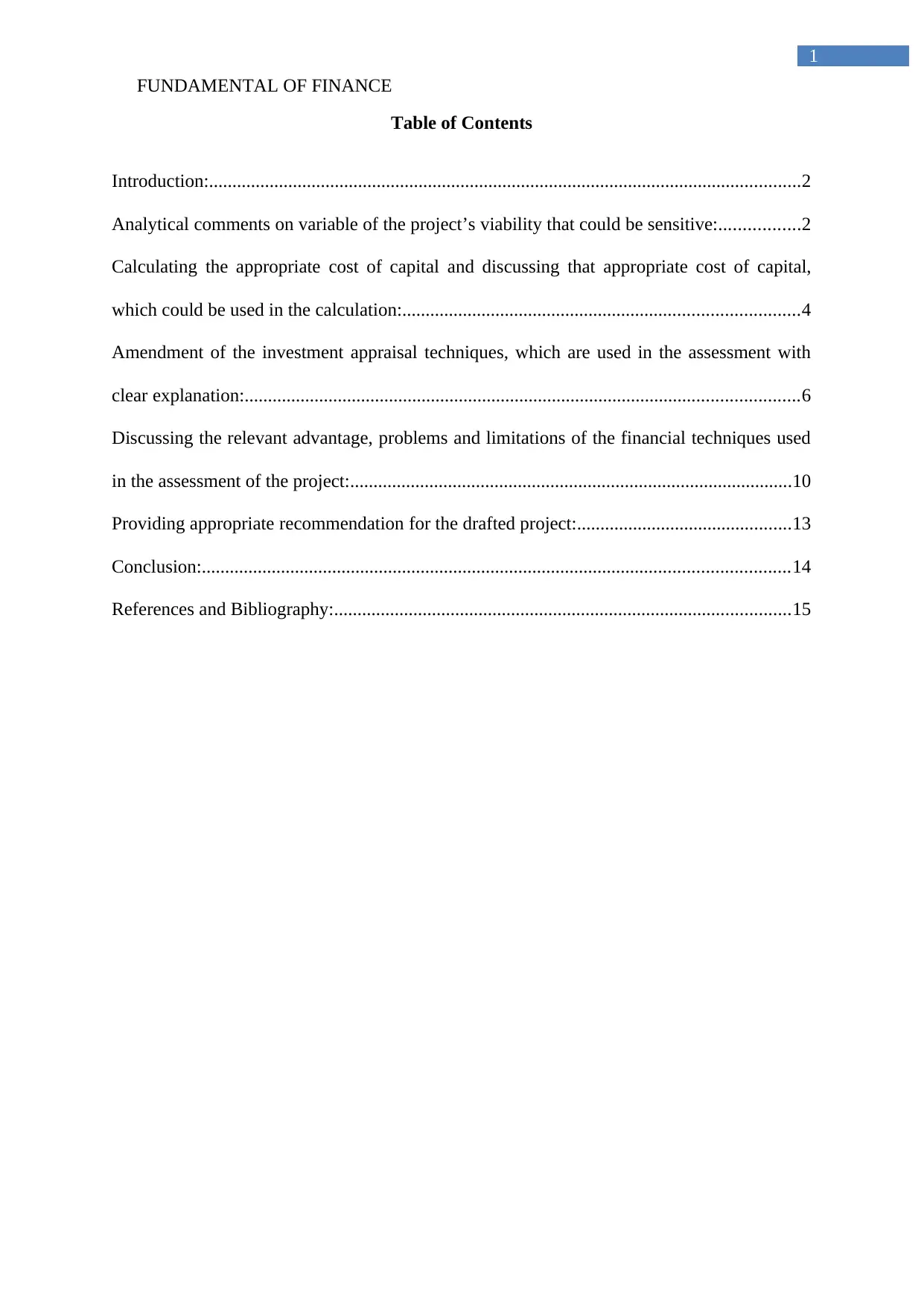
FUNDAMENTAL OF FINANCE
1
Table of Contents
Introduction:...............................................................................................................................2
Analytical comments on variable of the project’s viability that could be sensitive:.................2
Calculating the appropriate cost of capital and discussing that appropriate cost of capital,
which could be used in the calculation:.....................................................................................4
Amendment of the investment appraisal techniques, which are used in the assessment with
clear explanation:.......................................................................................................................6
Discussing the relevant advantage, problems and limitations of the financial techniques used
in the assessment of the project:...............................................................................................10
Providing appropriate recommendation for the drafted project:..............................................13
Conclusion:..............................................................................................................................14
References and Bibliography:..................................................................................................15
1
Table of Contents
Introduction:...............................................................................................................................2
Analytical comments on variable of the project’s viability that could be sensitive:.................2
Calculating the appropriate cost of capital and discussing that appropriate cost of capital,
which could be used in the calculation:.....................................................................................4
Amendment of the investment appraisal techniques, which are used in the assessment with
clear explanation:.......................................................................................................................6
Discussing the relevant advantage, problems and limitations of the financial techniques used
in the assessment of the project:...............................................................................................10
Providing appropriate recommendation for the drafted project:..............................................13
Conclusion:..............................................................................................................................14
References and Bibliography:..................................................................................................15
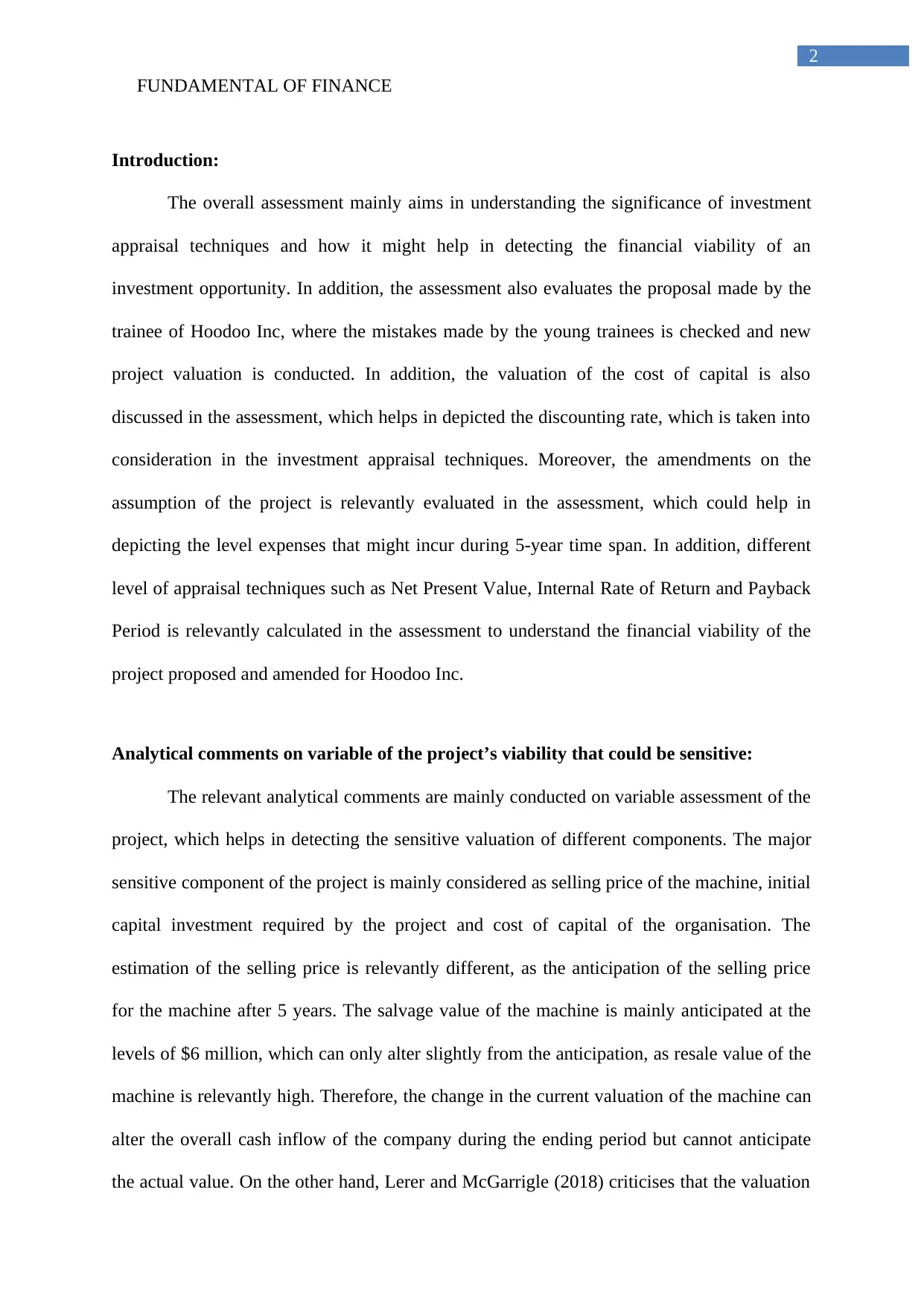
FUNDAMENTAL OF FINANCE
2
Introduction:
The overall assessment mainly aims in understanding the significance of investment
appraisal techniques and how it might help in detecting the financial viability of an
investment opportunity. In addition, the assessment also evaluates the proposal made by the
trainee of Hoodoo Inc, where the mistakes made by the young trainees is checked and new
project valuation is conducted. In addition, the valuation of the cost of capital is also
discussed in the assessment, which helps in depicted the discounting rate, which is taken into
consideration in the investment appraisal techniques. Moreover, the amendments on the
assumption of the project is relevantly evaluated in the assessment, which could help in
depicting the level expenses that might incur during 5-year time span. In addition, different
level of appraisal techniques such as Net Present Value, Internal Rate of Return and Payback
Period is relevantly calculated in the assessment to understand the financial viability of the
project proposed and amended for Hoodoo Inc.
Analytical comments on variable of the project’s viability that could be sensitive:
The relevant analytical comments are mainly conducted on variable assessment of the
project, which helps in detecting the sensitive valuation of different components. The major
sensitive component of the project is mainly considered as selling price of the machine, initial
capital investment required by the project and cost of capital of the organisation. The
estimation of the selling price is relevantly different, as the anticipation of the selling price
for the machine after 5 years. The salvage value of the machine is mainly anticipated at the
levels of $6 million, which can only alter slightly from the anticipation, as resale value of the
machine is relevantly high. Therefore, the change in the current valuation of the machine can
alter the overall cash inflow of the company during the ending period but cannot anticipate
the actual value. On the other hand, Lerer and McGarrigle (2018) criticises that the valuation
2
Introduction:
The overall assessment mainly aims in understanding the significance of investment
appraisal techniques and how it might help in detecting the financial viability of an
investment opportunity. In addition, the assessment also evaluates the proposal made by the
trainee of Hoodoo Inc, where the mistakes made by the young trainees is checked and new
project valuation is conducted. In addition, the valuation of the cost of capital is also
discussed in the assessment, which helps in depicted the discounting rate, which is taken into
consideration in the investment appraisal techniques. Moreover, the amendments on the
assumption of the project is relevantly evaluated in the assessment, which could help in
depicting the level expenses that might incur during 5-year time span. In addition, different
level of appraisal techniques such as Net Present Value, Internal Rate of Return and Payback
Period is relevantly calculated in the assessment to understand the financial viability of the
project proposed and amended for Hoodoo Inc.
Analytical comments on variable of the project’s viability that could be sensitive:
The relevant analytical comments are mainly conducted on variable assessment of the
project, which helps in detecting the sensitive valuation of different components. The major
sensitive component of the project is mainly considered as selling price of the machine, initial
capital investment required by the project and cost of capital of the organisation. The
estimation of the selling price is relevantly different, as the anticipation of the selling price
for the machine after 5 years. The salvage value of the machine is mainly anticipated at the
levels of $6 million, which can only alter slightly from the anticipation, as resale value of the
machine is relevantly high. Therefore, the change in the current valuation of the machine can
alter the overall cash inflow of the company during the ending period but cannot anticipate
the actual value. On the other hand, Lerer and McGarrigle (2018) criticises that the valuation
⊘ This is a preview!⊘
Do you want full access?
Subscribe today to unlock all pages.

Trusted by 1+ million students worldwide
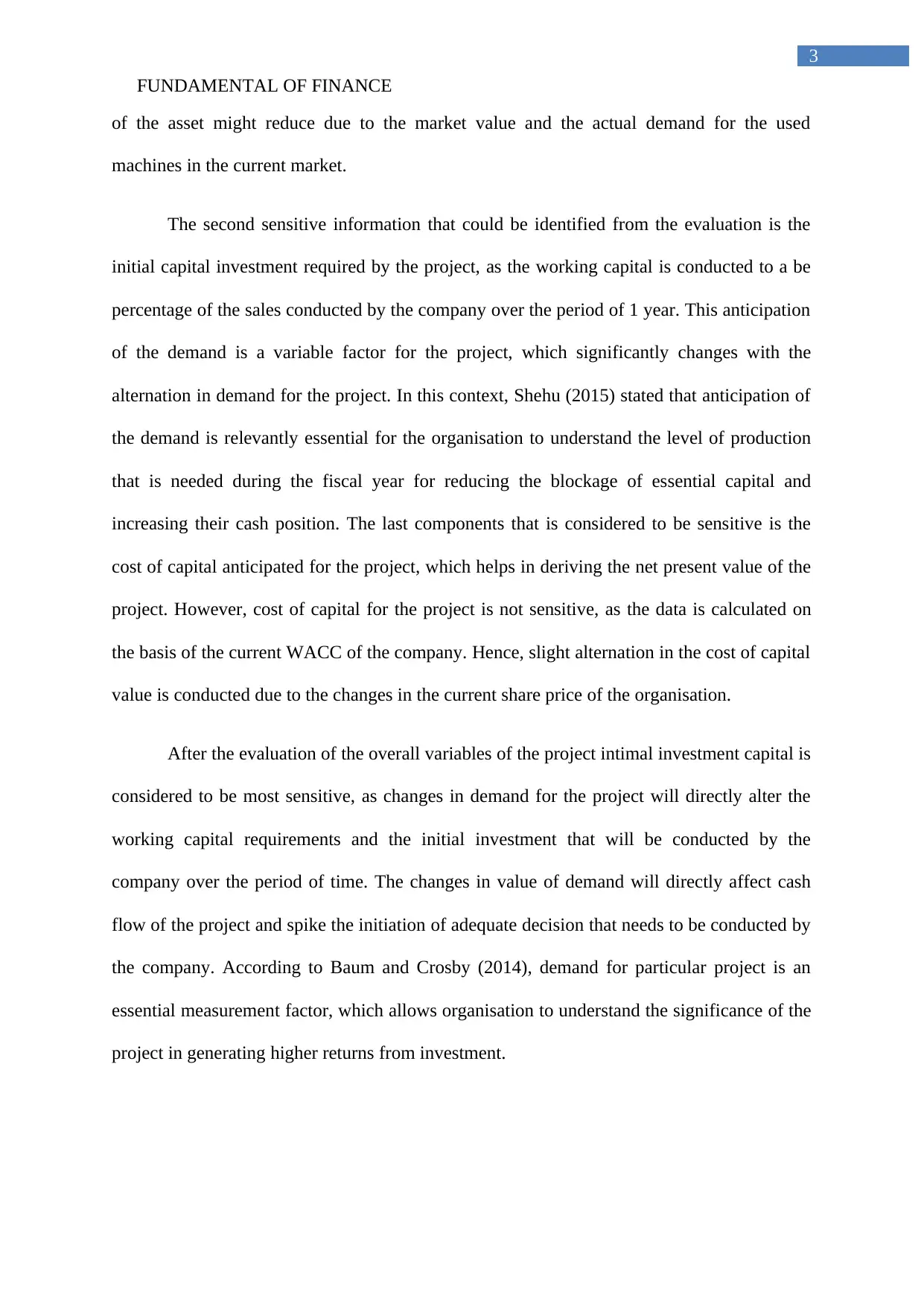
FUNDAMENTAL OF FINANCE
3
of the asset might reduce due to the market value and the actual demand for the used
machines in the current market.
The second sensitive information that could be identified from the evaluation is the
initial capital investment required by the project, as the working capital is conducted to a be
percentage of the sales conducted by the company over the period of 1 year. This anticipation
of the demand is a variable factor for the project, which significantly changes with the
alternation in demand for the project. In this context, Shehu (2015) stated that anticipation of
the demand is relevantly essential for the organisation to understand the level of production
that is needed during the fiscal year for reducing the blockage of essential capital and
increasing their cash position. The last components that is considered to be sensitive is the
cost of capital anticipated for the project, which helps in deriving the net present value of the
project. However, cost of capital for the project is not sensitive, as the data is calculated on
the basis of the current WACC of the company. Hence, slight alternation in the cost of capital
value is conducted due to the changes in the current share price of the organisation.
After the evaluation of the overall variables of the project intimal investment capital is
considered to be most sensitive, as changes in demand for the project will directly alter the
working capital requirements and the initial investment that will be conducted by the
company over the period of time. The changes in value of demand will directly affect cash
flow of the project and spike the initiation of adequate decision that needs to be conducted by
the company. According to Baum and Crosby (2014), demand for particular project is an
essential measurement factor, which allows organisation to understand the significance of the
project in generating higher returns from investment.
3
of the asset might reduce due to the market value and the actual demand for the used
machines in the current market.
The second sensitive information that could be identified from the evaluation is the
initial capital investment required by the project, as the working capital is conducted to a be
percentage of the sales conducted by the company over the period of 1 year. This anticipation
of the demand is a variable factor for the project, which significantly changes with the
alternation in demand for the project. In this context, Shehu (2015) stated that anticipation of
the demand is relevantly essential for the organisation to understand the level of production
that is needed during the fiscal year for reducing the blockage of essential capital and
increasing their cash position. The last components that is considered to be sensitive is the
cost of capital anticipated for the project, which helps in deriving the net present value of the
project. However, cost of capital for the project is not sensitive, as the data is calculated on
the basis of the current WACC of the company. Hence, slight alternation in the cost of capital
value is conducted due to the changes in the current share price of the organisation.
After the evaluation of the overall variables of the project intimal investment capital is
considered to be most sensitive, as changes in demand for the project will directly alter the
working capital requirements and the initial investment that will be conducted by the
company over the period of time. The changes in value of demand will directly affect cash
flow of the project and spike the initiation of adequate decision that needs to be conducted by
the company. According to Baum and Crosby (2014), demand for particular project is an
essential measurement factor, which allows organisation to understand the significance of the
project in generating higher returns from investment.
Paraphrase This Document
Need a fresh take? Get an instant paraphrase of this document with our AI Paraphraser
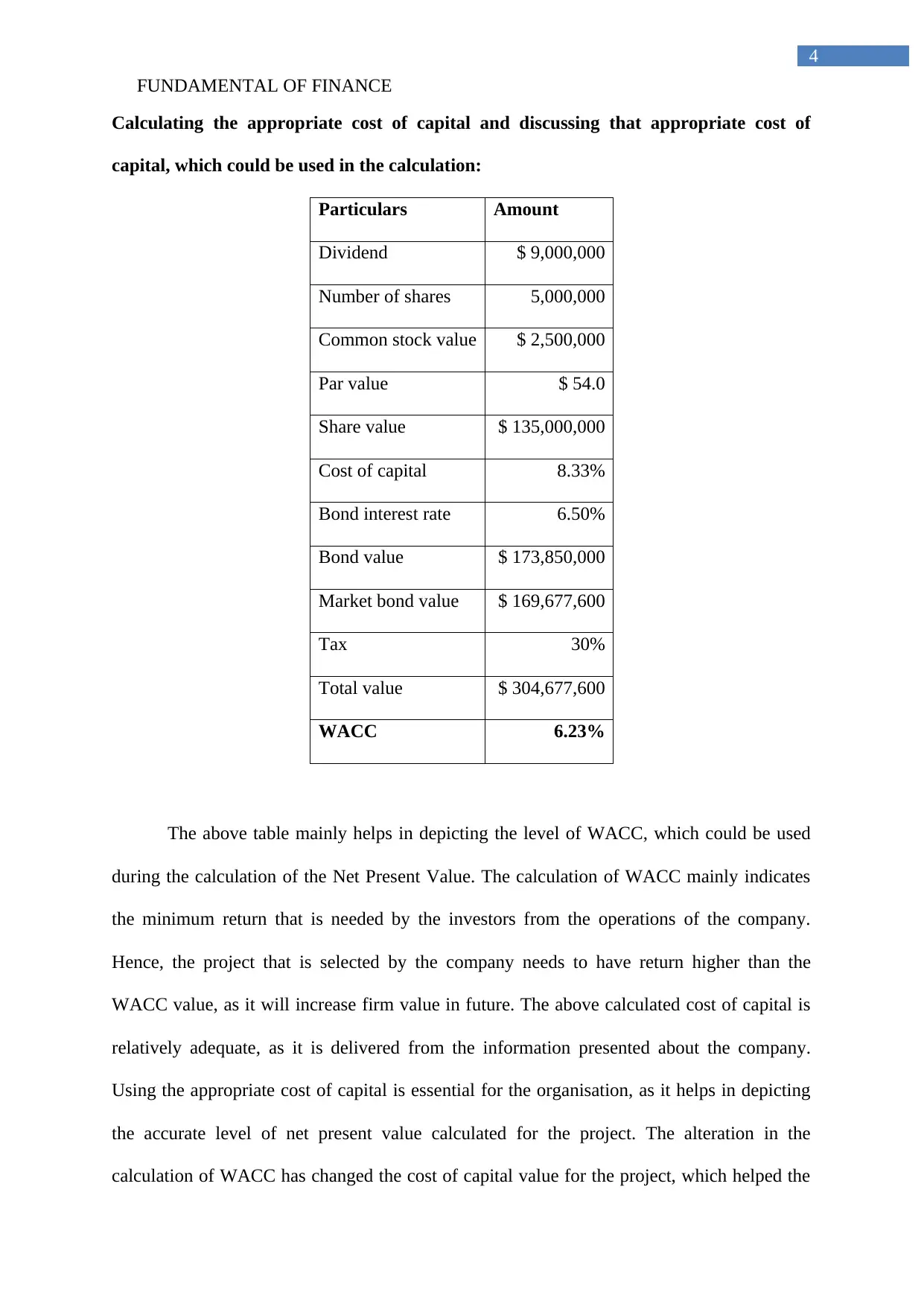
FUNDAMENTAL OF FINANCE
4
Calculating the appropriate cost of capital and discussing that appropriate cost of
capital, which could be used in the calculation:
Particulars Amount
Dividend $ 9,000,000
Number of shares 5,000,000
Common stock value $ 2,500,000
Par value $ 54.0
Share value $ 135,000,000
Cost of capital 8.33%
Bond interest rate 6.50%
Bond value $ 173,850,000
Market bond value $ 169,677,600
Tax 30%
Total value $ 304,677,600
WACC 6.23%
The above table mainly helps in depicting the level of WACC, which could be used
during the calculation of the Net Present Value. The calculation of WACC mainly indicates
the minimum return that is needed by the investors from the operations of the company.
Hence, the project that is selected by the company needs to have return higher than the
WACC value, as it will increase firm value in future. The above calculated cost of capital is
relatively adequate, as it is delivered from the information presented about the company.
Using the appropriate cost of capital is essential for the organisation, as it helps in depicting
the accurate level of net present value calculated for the project. The alteration in the
calculation of WACC has changed the cost of capital value for the project, which helped the
4
Calculating the appropriate cost of capital and discussing that appropriate cost of
capital, which could be used in the calculation:
Particulars Amount
Dividend $ 9,000,000
Number of shares 5,000,000
Common stock value $ 2,500,000
Par value $ 54.0
Share value $ 135,000,000
Cost of capital 8.33%
Bond interest rate 6.50%
Bond value $ 173,850,000
Market bond value $ 169,677,600
Tax 30%
Total value $ 304,677,600
WACC 6.23%
The above table mainly helps in depicting the level of WACC, which could be used
during the calculation of the Net Present Value. The calculation of WACC mainly indicates
the minimum return that is needed by the investors from the operations of the company.
Hence, the project that is selected by the company needs to have return higher than the
WACC value, as it will increase firm value in future. The above calculated cost of capital is
relatively adequate, as it is delivered from the information presented about the company.
Using the appropriate cost of capital is essential for the organisation, as it helps in depicting
the accurate level of net present value calculated for the project. The alteration in the
calculation of WACC has changed the cost of capital value for the project, which helped the
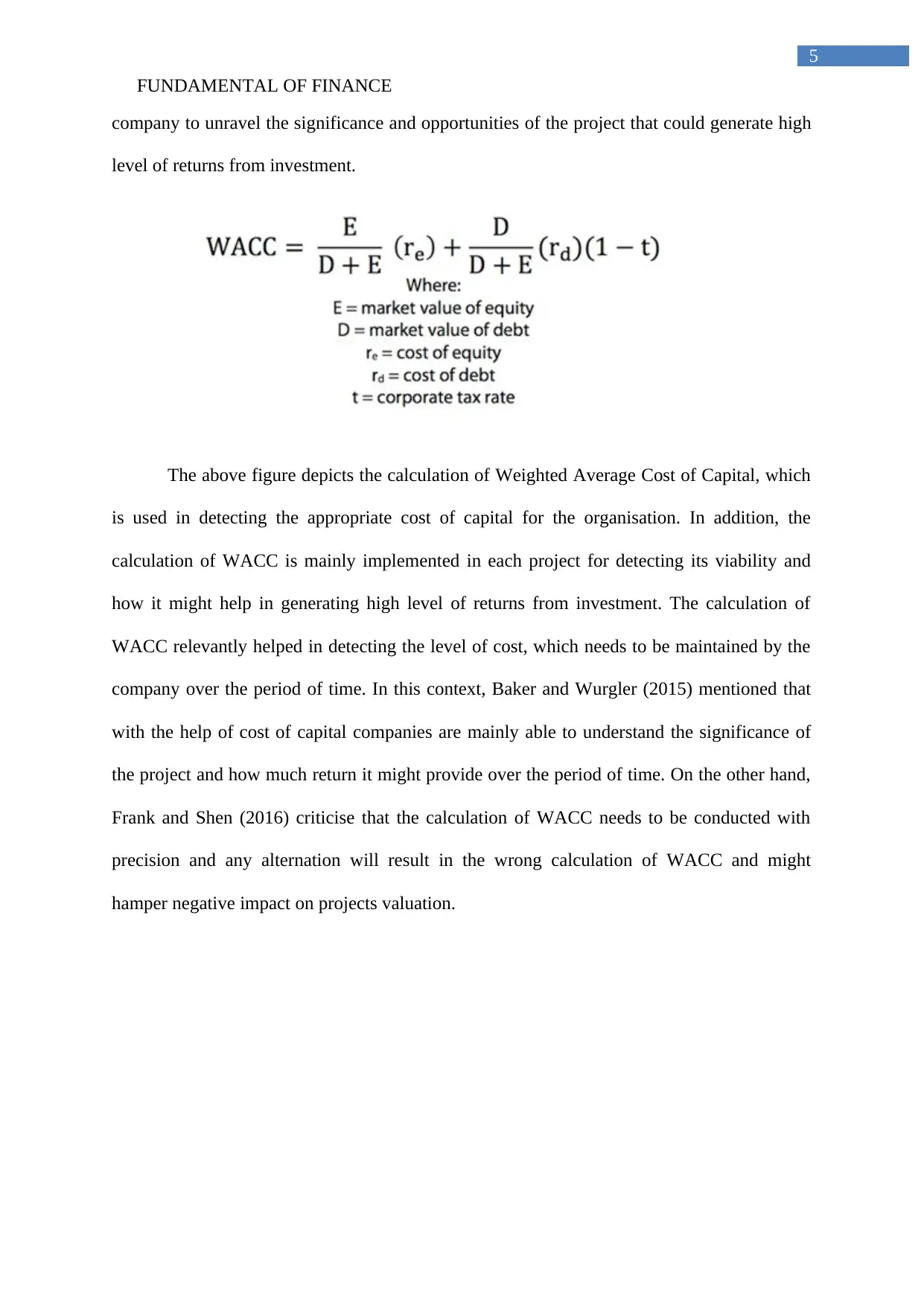
FUNDAMENTAL OF FINANCE
5
company to unravel the significance and opportunities of the project that could generate high
level of returns from investment.
The above figure depicts the calculation of Weighted Average Cost of Capital, which
is used in detecting the appropriate cost of capital for the organisation. In addition, the
calculation of WACC is mainly implemented in each project for detecting its viability and
how it might help in generating high level of returns from investment. The calculation of
WACC relevantly helped in detecting the level of cost, which needs to be maintained by the
company over the period of time. In this context, Baker and Wurgler (2015) mentioned that
with the help of cost of capital companies are mainly able to understand the significance of
the project and how much return it might provide over the period of time. On the other hand,
Frank and Shen (2016) criticise that the calculation of WACC needs to be conducted with
precision and any alternation will result in the wrong calculation of WACC and might
hamper negative impact on projects valuation.
5
company to unravel the significance and opportunities of the project that could generate high
level of returns from investment.
The above figure depicts the calculation of Weighted Average Cost of Capital, which
is used in detecting the appropriate cost of capital for the organisation. In addition, the
calculation of WACC is mainly implemented in each project for detecting its viability and
how it might help in generating high level of returns from investment. The calculation of
WACC relevantly helped in detecting the level of cost, which needs to be maintained by the
company over the period of time. In this context, Baker and Wurgler (2015) mentioned that
with the help of cost of capital companies are mainly able to understand the significance of
the project and how much return it might provide over the period of time. On the other hand,
Frank and Shen (2016) criticise that the calculation of WACC needs to be conducted with
precision and any alternation will result in the wrong calculation of WACC and might
hamper negative impact on projects valuation.
⊘ This is a preview!⊘
Do you want full access?
Subscribe today to unlock all pages.

Trusted by 1+ million students worldwide
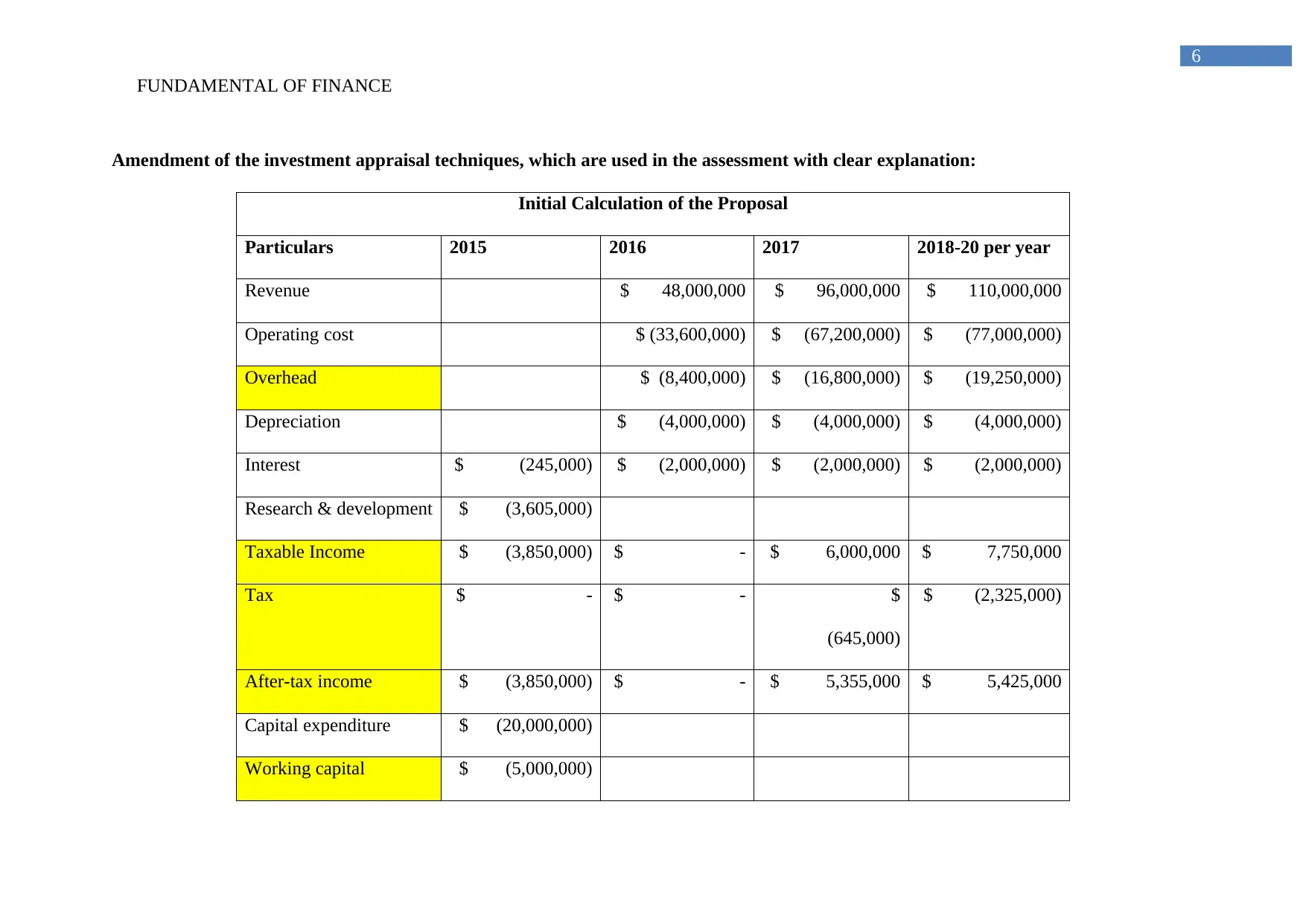
FUNDAMENTAL OF FINANCE
6
Amendment of the investment appraisal techniques, which are used in the assessment with clear explanation:
Initial Calculation of the Proposal
Particulars 2015 2016 2017 2018-20 per year
Revenue $ 48,000,000 $ 96,000,000 $ 110,000,000
Operating cost $ (33,600,000) $ (67,200,000) $ (77,000,000)
Overhead $ (8,400,000) $ (16,800,000) $ (19,250,000)
Depreciation $ (4,000,000) $ (4,000,000) $ (4,000,000)
Interest $ (245,000) $ (2,000,000) $ (2,000,000) $ (2,000,000)
Research & development $ (3,605,000)
Taxable Income $ (3,850,000) $ - $ 6,000,000 $ 7,750,000
Tax $ - $ - $
(645,000)
$ (2,325,000)
After-tax income $ (3,850,000) $ - $ 5,355,000 $ 5,425,000
Capital expenditure $ (20,000,000)
Working capital $ (5,000,000)
6
Amendment of the investment appraisal techniques, which are used in the assessment with clear explanation:
Initial Calculation of the Proposal
Particulars 2015 2016 2017 2018-20 per year
Revenue $ 48,000,000 $ 96,000,000 $ 110,000,000
Operating cost $ (33,600,000) $ (67,200,000) $ (77,000,000)
Overhead $ (8,400,000) $ (16,800,000) $ (19,250,000)
Depreciation $ (4,000,000) $ (4,000,000) $ (4,000,000)
Interest $ (245,000) $ (2,000,000) $ (2,000,000) $ (2,000,000)
Research & development $ (3,605,000)
Taxable Income $ (3,850,000) $ - $ 6,000,000 $ 7,750,000
Tax $ - $ - $
(645,000)
$ (2,325,000)
After-tax income $ (3,850,000) $ - $ 5,355,000 $ 5,425,000
Capital expenditure $ (20,000,000)
Working capital $ (5,000,000)
Paraphrase This Document
Need a fresh take? Get an instant paraphrase of this document with our AI Paraphraser
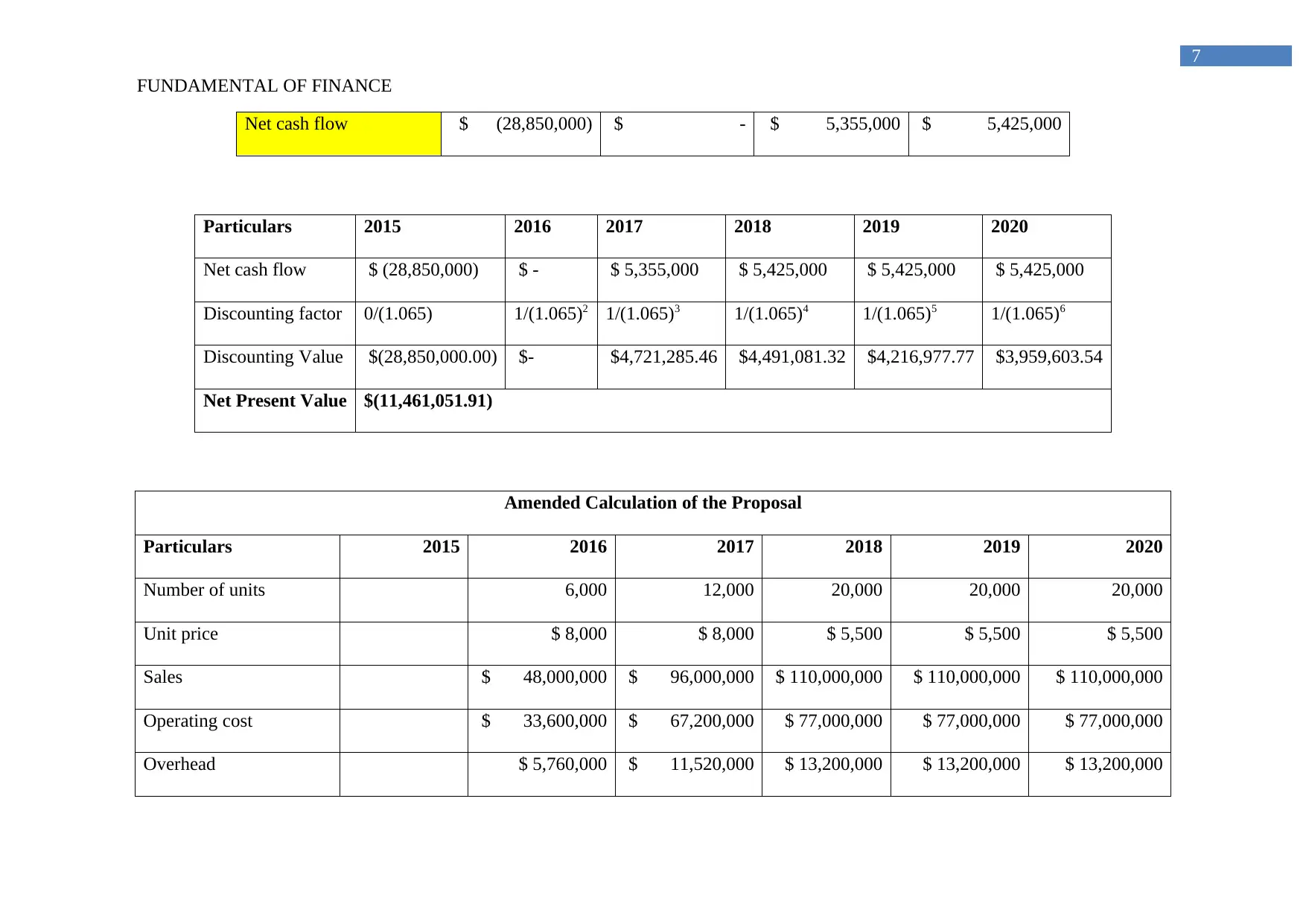
FUNDAMENTAL OF FINANCE
7
Net cash flow $ (28,850,000) $ - $ 5,355,000 $ 5,425,000
Particulars 2015 2016 2017 2018 2019 2020
Net cash flow $ (28,850,000) $ - $ 5,355,000 $ 5,425,000 $ 5,425,000 $ 5,425,000
Discounting factor 0/(1.065) 1/(1.065)2 1/(1.065)3 1/(1.065)4 1/(1.065)5 1/(1.065)6
Discounting Value $(28,850,000.00) $- $4,721,285.46 $4,491,081.32 $4,216,977.77 $3,959,603.54
Net Present Value $(11,461,051.91)
Amended Calculation of the Proposal
Particulars 2015 2016 2017 2018 2019 2020
Number of units 6,000 12,000 20,000 20,000 20,000
Unit price $ 8,000 $ 8,000 $ 5,500 $ 5,500 $ 5,500
Sales $ 48,000,000 $ 96,000,000 $ 110,000,000 $ 110,000,000 $ 110,000,000
Operating cost $ 33,600,000 $ 67,200,000 $ 77,000,000 $ 77,000,000 $ 77,000,000
Overhead $ 5,760,000 $ 11,520,000 $ 13,200,000 $ 13,200,000 $ 13,200,000
7
Net cash flow $ (28,850,000) $ - $ 5,355,000 $ 5,425,000
Particulars 2015 2016 2017 2018 2019 2020
Net cash flow $ (28,850,000) $ - $ 5,355,000 $ 5,425,000 $ 5,425,000 $ 5,425,000
Discounting factor 0/(1.065) 1/(1.065)2 1/(1.065)3 1/(1.065)4 1/(1.065)5 1/(1.065)6
Discounting Value $(28,850,000.00) $- $4,721,285.46 $4,491,081.32 $4,216,977.77 $3,959,603.54
Net Present Value $(11,461,051.91)
Amended Calculation of the Proposal
Particulars 2015 2016 2017 2018 2019 2020
Number of units 6,000 12,000 20,000 20,000 20,000
Unit price $ 8,000 $ 8,000 $ 5,500 $ 5,500 $ 5,500
Sales $ 48,000,000 $ 96,000,000 $ 110,000,000 $ 110,000,000 $ 110,000,000
Operating cost $ 33,600,000 $ 67,200,000 $ 77,000,000 $ 77,000,000 $ 77,000,000
Overhead $ 5,760,000 $ 11,520,000 $ 13,200,000 $ 13,200,000 $ 13,200,000
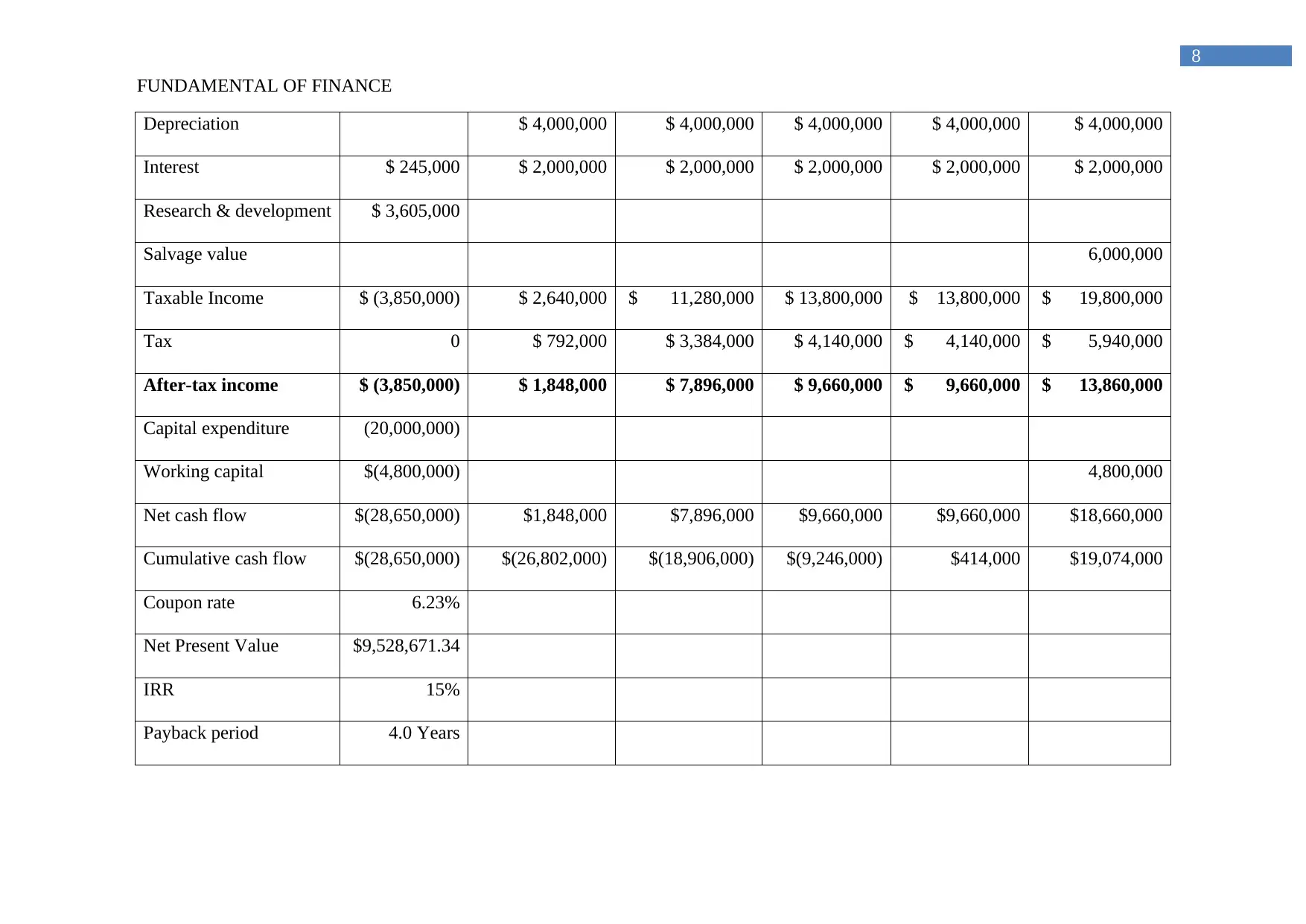
FUNDAMENTAL OF FINANCE
8
Depreciation $ 4,000,000 $ 4,000,000 $ 4,000,000 $ 4,000,000 $ 4,000,000
Interest $ 245,000 $ 2,000,000 $ 2,000,000 $ 2,000,000 $ 2,000,000 $ 2,000,000
Research & development $ 3,605,000
Salvage value 6,000,000
Taxable Income $ (3,850,000) $ 2,640,000 $ 11,280,000 $ 13,800,000 $ 13,800,000 $ 19,800,000
Tax 0 $ 792,000 $ 3,384,000 $ 4,140,000 $ 4,140,000 $ 5,940,000
After-tax income $ (3,850,000) $ 1,848,000 $ 7,896,000 $ 9,660,000 $ 9,660,000 $ 13,860,000
Capital expenditure (20,000,000)
Working capital $(4,800,000) 4,800,000
Net cash flow $(28,650,000) $1,848,000 $7,896,000 $9,660,000 $9,660,000 $18,660,000
Cumulative cash flow $(28,650,000) $(26,802,000) $(18,906,000) $(9,246,000) $414,000 $19,074,000
Coupon rate 6.23%
Net Present Value $9,528,671.34
IRR 15%
Payback period 4.0 Years
8
Depreciation $ 4,000,000 $ 4,000,000 $ 4,000,000 $ 4,000,000 $ 4,000,000
Interest $ 245,000 $ 2,000,000 $ 2,000,000 $ 2,000,000 $ 2,000,000 $ 2,000,000
Research & development $ 3,605,000
Salvage value 6,000,000
Taxable Income $ (3,850,000) $ 2,640,000 $ 11,280,000 $ 13,800,000 $ 13,800,000 $ 19,800,000
Tax 0 $ 792,000 $ 3,384,000 $ 4,140,000 $ 4,140,000 $ 5,940,000
After-tax income $ (3,850,000) $ 1,848,000 $ 7,896,000 $ 9,660,000 $ 9,660,000 $ 13,860,000
Capital expenditure (20,000,000)
Working capital $(4,800,000) 4,800,000
Net cash flow $(28,650,000) $1,848,000 $7,896,000 $9,660,000 $9,660,000 $18,660,000
Cumulative cash flow $(28,650,000) $(26,802,000) $(18,906,000) $(9,246,000) $414,000 $19,074,000
Coupon rate 6.23%
Net Present Value $9,528,671.34
IRR 15%
Payback period 4.0 Years
⊘ This is a preview!⊘
Do you want full access?
Subscribe today to unlock all pages.

Trusted by 1+ million students worldwide
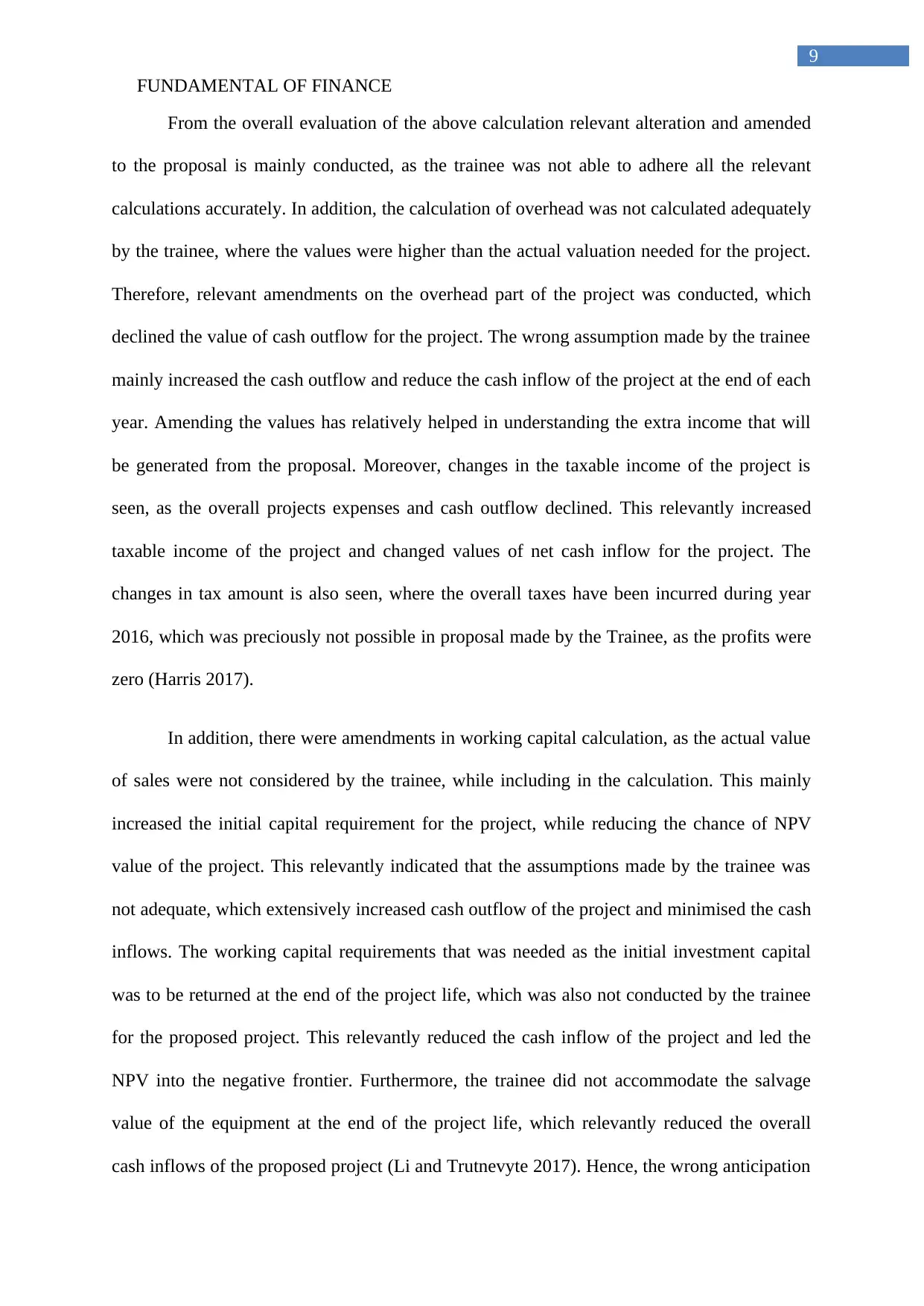
FUNDAMENTAL OF FINANCE
9
From the overall evaluation of the above calculation relevant alteration and amended
to the proposal is mainly conducted, as the trainee was not able to adhere all the relevant
calculations accurately. In addition, the calculation of overhead was not calculated adequately
by the trainee, where the values were higher than the actual valuation needed for the project.
Therefore, relevant amendments on the overhead part of the project was conducted, which
declined the value of cash outflow for the project. The wrong assumption made by the trainee
mainly increased the cash outflow and reduce the cash inflow of the project at the end of each
year. Amending the values has relatively helped in understanding the extra income that will
be generated from the proposal. Moreover, changes in the taxable income of the project is
seen, as the overall projects expenses and cash outflow declined. This relevantly increased
taxable income of the project and changed values of net cash inflow for the project. The
changes in tax amount is also seen, where the overall taxes have been incurred during year
2016, which was preciously not possible in proposal made by the Trainee, as the profits were
zero (Harris 2017).
In addition, there were amendments in working capital calculation, as the actual value
of sales were not considered by the trainee, while including in the calculation. This mainly
increased the initial capital requirement for the project, while reducing the chance of NPV
value of the project. This relevantly indicated that the assumptions made by the trainee was
not adequate, which extensively increased cash outflow of the project and minimised the cash
inflows. The working capital requirements that was needed as the initial investment capital
was to be returned at the end of the project life, which was also not conducted by the trainee
for the proposed project. This relevantly reduced the cash inflow of the project and led the
NPV into the negative frontier. Furthermore, the trainee did not accommodate the salvage
value of the equipment at the end of the project life, which relevantly reduced the overall
cash inflows of the proposed project (Li and Trutnevyte 2017). Hence, the wrong anticipation
9
From the overall evaluation of the above calculation relevant alteration and amended
to the proposal is mainly conducted, as the trainee was not able to adhere all the relevant
calculations accurately. In addition, the calculation of overhead was not calculated adequately
by the trainee, where the values were higher than the actual valuation needed for the project.
Therefore, relevant amendments on the overhead part of the project was conducted, which
declined the value of cash outflow for the project. The wrong assumption made by the trainee
mainly increased the cash outflow and reduce the cash inflow of the project at the end of each
year. Amending the values has relatively helped in understanding the extra income that will
be generated from the proposal. Moreover, changes in the taxable income of the project is
seen, as the overall projects expenses and cash outflow declined. This relevantly increased
taxable income of the project and changed values of net cash inflow for the project. The
changes in tax amount is also seen, where the overall taxes have been incurred during year
2016, which was preciously not possible in proposal made by the Trainee, as the profits were
zero (Harris 2017).
In addition, there were amendments in working capital calculation, as the actual value
of sales were not considered by the trainee, while including in the calculation. This mainly
increased the initial capital requirement for the project, while reducing the chance of NPV
value of the project. This relevantly indicated that the assumptions made by the trainee was
not adequate, which extensively increased cash outflow of the project and minimised the cash
inflows. The working capital requirements that was needed as the initial investment capital
was to be returned at the end of the project life, which was also not conducted by the trainee
for the proposed project. This relevantly reduced the cash inflow of the project and led the
NPV into the negative frontier. Furthermore, the trainee did not accommodate the salvage
value of the equipment at the end of the project life, which relevantly reduced the overall
cash inflows of the proposed project (Li and Trutnevyte 2017). Hence, the wrong anticipation
Paraphrase This Document
Need a fresh take? Get an instant paraphrase of this document with our AI Paraphraser
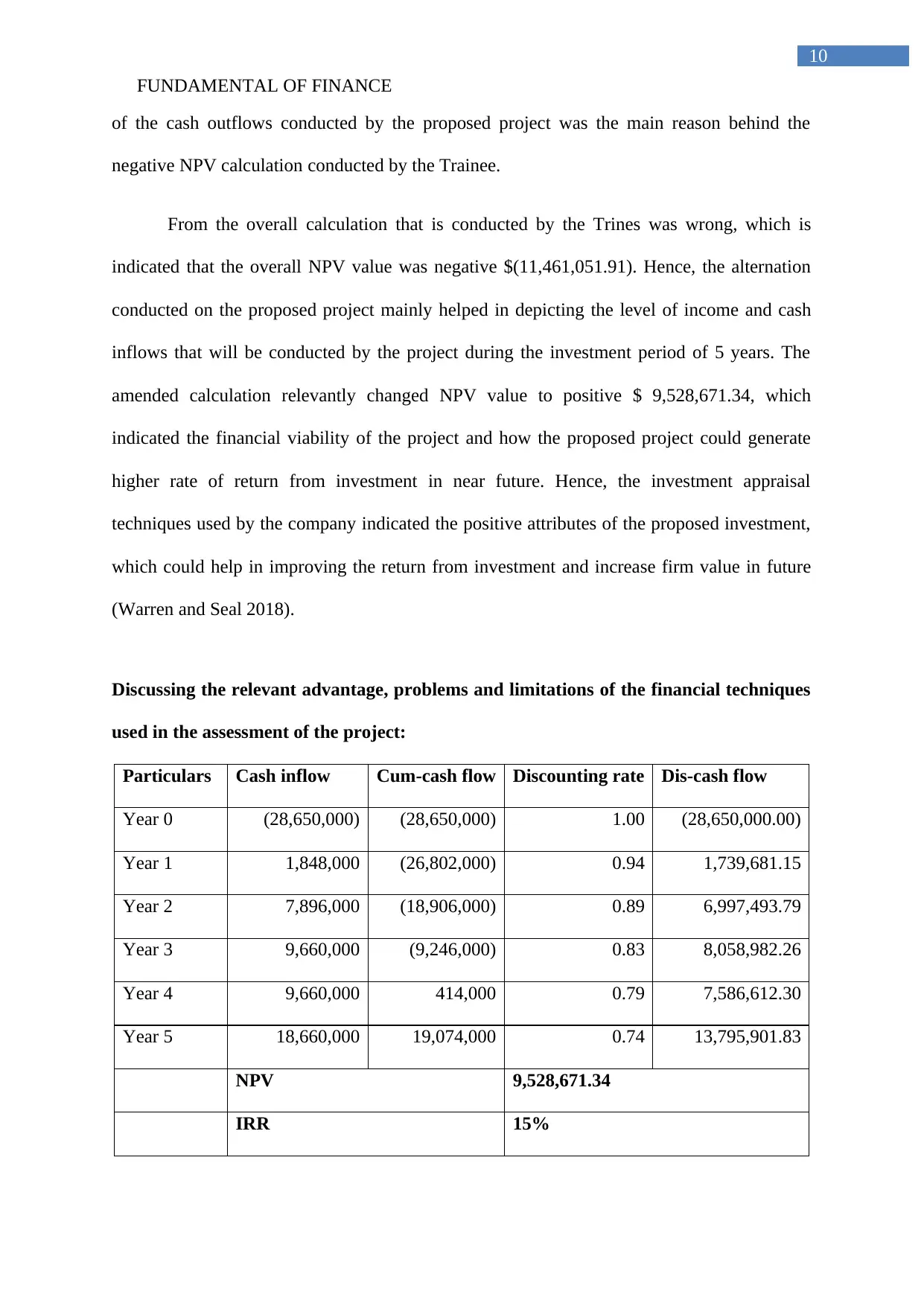
FUNDAMENTAL OF FINANCE
10
of the cash outflows conducted by the proposed project was the main reason behind the
negative NPV calculation conducted by the Trainee.
From the overall calculation that is conducted by the Trines was wrong, which is
indicated that the overall NPV value was negative $(11,461,051.91). Hence, the alternation
conducted on the proposed project mainly helped in depicting the level of income and cash
inflows that will be conducted by the project during the investment period of 5 years. The
amended calculation relevantly changed NPV value to positive $ 9,528,671.34, which
indicated the financial viability of the project and how the proposed project could generate
higher rate of return from investment in near future. Hence, the investment appraisal
techniques used by the company indicated the positive attributes of the proposed investment,
which could help in improving the return from investment and increase firm value in future
(Warren and Seal 2018).
Discussing the relevant advantage, problems and limitations of the financial techniques
used in the assessment of the project:
Particulars Cash inflow Cum-cash flow Discounting rate Dis-cash flow
Year 0 (28,650,000) (28,650,000) 1.00 (28,650,000.00)
Year 1 1,848,000 (26,802,000) 0.94 1,739,681.15
Year 2 7,896,000 (18,906,000) 0.89 6,997,493.79
Year 3 9,660,000 (9,246,000) 0.83 8,058,982.26
Year 4 9,660,000 414,000 0.79 7,586,612.30
Year 5 18,660,000 19,074,000 0.74 13,795,901.83
NPV 9,528,671.34
IRR 15%
10
of the cash outflows conducted by the proposed project was the main reason behind the
negative NPV calculation conducted by the Trainee.
From the overall calculation that is conducted by the Trines was wrong, which is
indicated that the overall NPV value was negative $(11,461,051.91). Hence, the alternation
conducted on the proposed project mainly helped in depicting the level of income and cash
inflows that will be conducted by the project during the investment period of 5 years. The
amended calculation relevantly changed NPV value to positive $ 9,528,671.34, which
indicated the financial viability of the project and how the proposed project could generate
higher rate of return from investment in near future. Hence, the investment appraisal
techniques used by the company indicated the positive attributes of the proposed investment,
which could help in improving the return from investment and increase firm value in future
(Warren and Seal 2018).
Discussing the relevant advantage, problems and limitations of the financial techniques
used in the assessment of the project:
Particulars Cash inflow Cum-cash flow Discounting rate Dis-cash flow
Year 0 (28,650,000) (28,650,000) 1.00 (28,650,000.00)
Year 1 1,848,000 (26,802,000) 0.94 1,739,681.15
Year 2 7,896,000 (18,906,000) 0.89 6,997,493.79
Year 3 9,660,000 (9,246,000) 0.83 8,058,982.26
Year 4 9,660,000 414,000 0.79 7,586,612.30
Year 5 18,660,000 19,074,000 0.74 13,795,901.83
NPV 9,528,671.34
IRR 15%
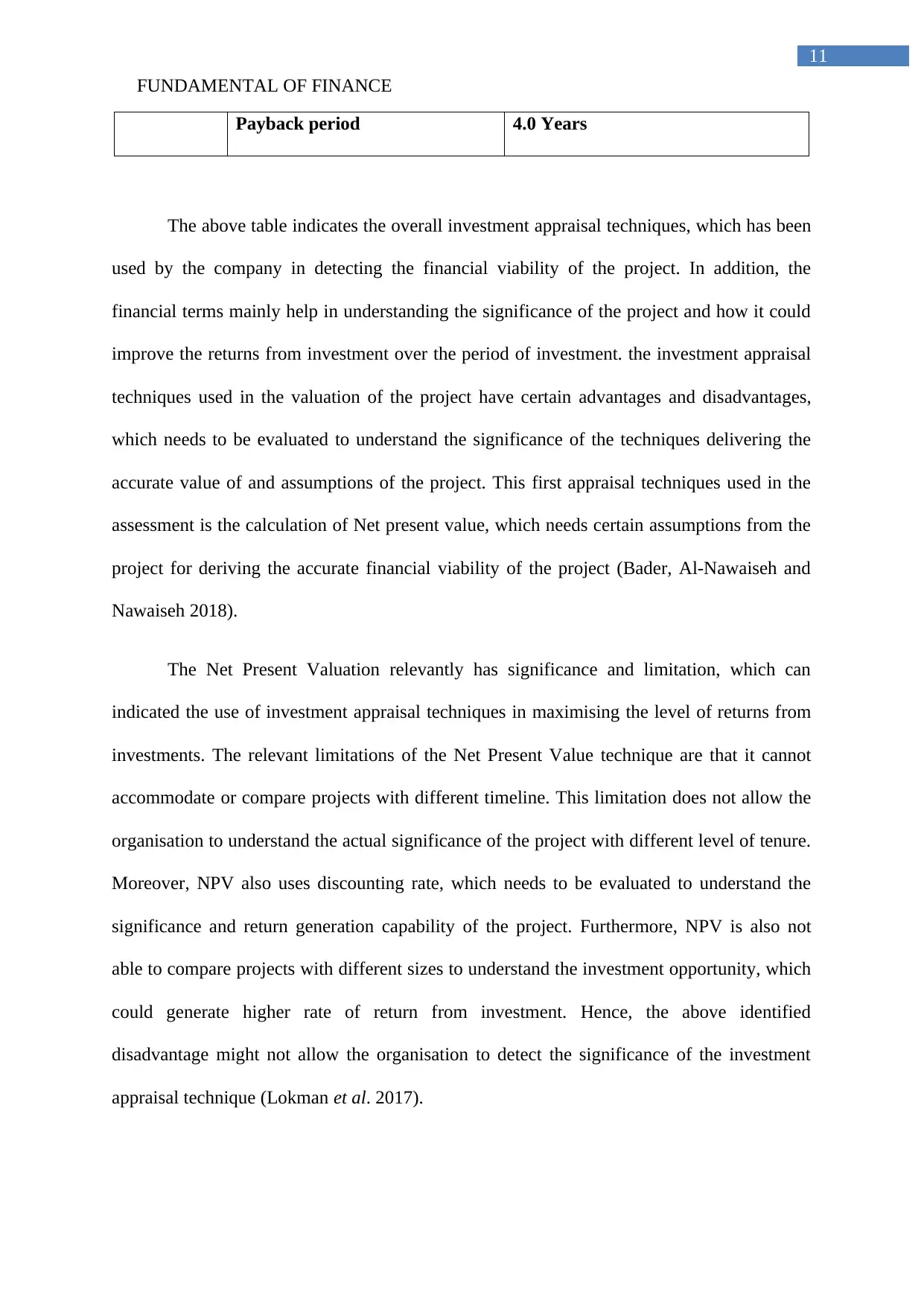
FUNDAMENTAL OF FINANCE
11
Payback period 4.0 Years
The above table indicates the overall investment appraisal techniques, which has been
used by the company in detecting the financial viability of the project. In addition, the
financial terms mainly help in understanding the significance of the project and how it could
improve the returns from investment over the period of investment. the investment appraisal
techniques used in the valuation of the project have certain advantages and disadvantages,
which needs to be evaluated to understand the significance of the techniques delivering the
accurate value of and assumptions of the project. This first appraisal techniques used in the
assessment is the calculation of Net present value, which needs certain assumptions from the
project for deriving the accurate financial viability of the project (Bader, Al-Nawaiseh and
Nawaiseh 2018).
The Net Present Valuation relevantly has significance and limitation, which can
indicated the use of investment appraisal techniques in maximising the level of returns from
investments. The relevant limitations of the Net Present Value technique are that it cannot
accommodate or compare projects with different timeline. This limitation does not allow the
organisation to understand the actual significance of the project with different level of tenure.
Moreover, NPV also uses discounting rate, which needs to be evaluated to understand the
significance and return generation capability of the project. Furthermore, NPV is also not
able to compare projects with different sizes to understand the investment opportunity, which
could generate higher rate of return from investment. Hence, the above identified
disadvantage might not allow the organisation to detect the significance of the investment
appraisal technique (Lokman et al. 2017).
11
Payback period 4.0 Years
The above table indicates the overall investment appraisal techniques, which has been
used by the company in detecting the financial viability of the project. In addition, the
financial terms mainly help in understanding the significance of the project and how it could
improve the returns from investment over the period of investment. the investment appraisal
techniques used in the valuation of the project have certain advantages and disadvantages,
which needs to be evaluated to understand the significance of the techniques delivering the
accurate value of and assumptions of the project. This first appraisal techniques used in the
assessment is the calculation of Net present value, which needs certain assumptions from the
project for deriving the accurate financial viability of the project (Bader, Al-Nawaiseh and
Nawaiseh 2018).
The Net Present Valuation relevantly has significance and limitation, which can
indicated the use of investment appraisal techniques in maximising the level of returns from
investments. The relevant limitations of the Net Present Value technique are that it cannot
accommodate or compare projects with different timeline. This limitation does not allow the
organisation to understand the actual significance of the project with different level of tenure.
Moreover, NPV also uses discounting rate, which needs to be evaluated to understand the
significance and return generation capability of the project. Furthermore, NPV is also not
able to compare projects with different sizes to understand the investment opportunity, which
could generate higher rate of return from investment. Hence, the above identified
disadvantage might not allow the organisation to detect the significance of the investment
appraisal technique (Lokman et al. 2017).
⊘ This is a preview!⊘
Do you want full access?
Subscribe today to unlock all pages.

Trusted by 1+ million students worldwide
1 out of 18
Related Documents
Your All-in-One AI-Powered Toolkit for Academic Success.
+13062052269
info@desklib.com
Available 24*7 on WhatsApp / Email
![[object Object]](/_next/static/media/star-bottom.7253800d.svg)
Unlock your academic potential
Copyright © 2020–2026 A2Z Services. All Rights Reserved. Developed and managed by ZUCOL.




